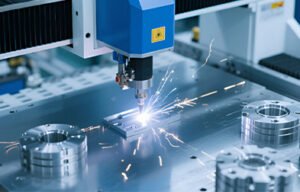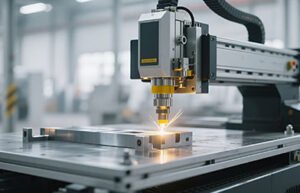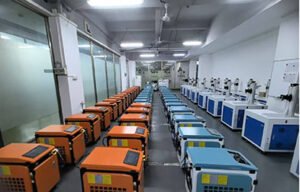- Home
- »
- Uncategorized
- »
- Are Laser Weldi…
BLOG
CONTACT US
Are Laser Welding Machines Suitable for Kitchen Equipment Manufacturing
Introduction to Kitchen Equipment Manufacturing Challenges
Manufacturing kitchen equipment requires meeting high standards of quality, durability, and aesthetic appeal. Kitchen appliances and fixtures such as sinks, cabinets, ovens, and hoods are mainly made from stainless steel or other corrosion-resistant metals. These products must withstand daily use, moisture, and cleaning chemicals, making strong and neat welds essential. Traditional welding methods often struggle to deliver the consistency, speed, and clean appearance that modern kitchen manufacturers demand.
This brings us to the question: Are laser welding machines a suitable solution for kitchen equipment manufacturing?
Overview of Laser Welding Technology
Laser welding uses a concentrated laser beam to join metals by melting them at the weld joint with high precision. Its key features include:
Non-contact welding with minimal heat affected zones
Deep penetration and narrow weld seams
High welding speed and automation capability
Ability to weld thin and thick metals with excellent control
Laser welding machines vary from handheld fiber laser welders for flexible operations to platform and scanner-based systems for automated production.
Materials Commonly Used in Kitchen Equipment
Most kitchen equipment is manufactured using stainless steel types like 304 and 316 due to their corrosion resistance and hygienic properties. Other metals like aluminum and galvanized steel are also used in certain components. Laser welding is particularly well suited for stainless steel, as it produces clean welds without compromising corrosion resistance or surface finish.
Advantages of Using Laser Welding Machines in Kitchen Equipment Manufacturing
1. Superior Weld Quality and Aesthetics
Laser welding produces precise, narrow seams with minimal discoloration and distortion, critical for kitchen appliances where welds are often visible.
2. Increased Production Efficiency
With higher welding speeds and automated options, laser welding can significantly boost manufacturing throughput.
3. Enhanced Durability and Hygiene
Continuous welds without gaps reduce the risk of bacterial growth and increase resistance to moisture and chemicals, vital for kitchen environments.
4. Reduced Material Distortion and Post-Processing
Minimal heat input lowers the chance of warping thin metal sheets, and often no grinding or polishing is required after welding.
5. Flexibility Across Product Types
Laser welding machines can handle a range of product sizes and shapes, from sinks to large oven frames, allowing manufacturers to diversify without changing equipment.
Comparison Between Laser Welding and Traditional Welding Methods
| Feature | TIG Welding | MIG Welding | Spot Welding | Laser Welding |
|---|---|---|---|---|
| Heat Affected Zone | Large | Moderate | Large | Minimal |
| Welding Speed | Slow | Moderate | Fast | Very Fast |
| Weld Seam Appearance | Moderate | Moderate | Poor | Excellent |
| Automation Capability | Low | Medium | Low | High |
| Post-Weld Processing | Required | Required | Usually required | Minimal |
Laser welding outperforms traditional methods in speed, precision, and weld aesthetics, all essential factors in kitchen equipment production.
Types of Laser Welding Machines Suitable for Kitchen Equipment
Handheld Fiber Laser Welders
Portable and flexible, ideal for large or complex kitchen components that require on-site or variable positioning welding.
Platform Laser Welding Machines
Fixed setups suitable for batch production of standardized parts like sinks and stove panels, providing consistent high-quality welds.
Scanner-Based (Galvo) Laser Welders
Perfect for fast spot welding and intricate weld patterns on smaller kitchen hardware components.
Automatic Robotic Laser Welding Systems
For large-scale manufacturers aiming for maximum efficiency and precision with robotic arms and conveyor integration.
Real-world Applications and Case Studies
Case Study 1: Stainless Steel Kitchen Sink Production
A manufacturer introduced a platform fiber laser welding machine, achieving a 30% reduction in welding time and significantly improved surface finish, reducing polishing costs.
Case Study 2: Kitchen Appliance Frame Welding
Using handheld laser welding machines, a factory improved welding quality and minimized distortion on oven and range hood frames.
Case Study 3: Automated Batch Production of Kitchen Cabinets
An OEM supplier deployed automatic laser welding systems to boost throughput and maintain strict quality standards across thousands of units monthly.
Implementation Considerations for Manufacturers
Before integrating laser welding machines, manufacturers should assess:
Initial investment costs and ROI timelines
Operator training and safety protocols
Material thickness and welding speed requirements
Appropriate shielding gases like argon or nitrogen
Workpiece fixturing for automated systems
Proper planning ensures smooth transition and maximum benefits.
Conclusion: Is Laser Welding the Future for Kitchen Equipment Production?
Given its advantages in precision, speed, and weld quality, laser welding machines are not only suitable but increasingly essential for modern kitchen equipment manufacturing. They enable manufacturers to produce durable, hygienic, and visually appealing products efficiently, meeting the evolving demands of global markets.
Choosing the right laser welding technology can future-proof your kitchen equipment business and position it competitively in a demanding industry.
111-1024x458.png)


